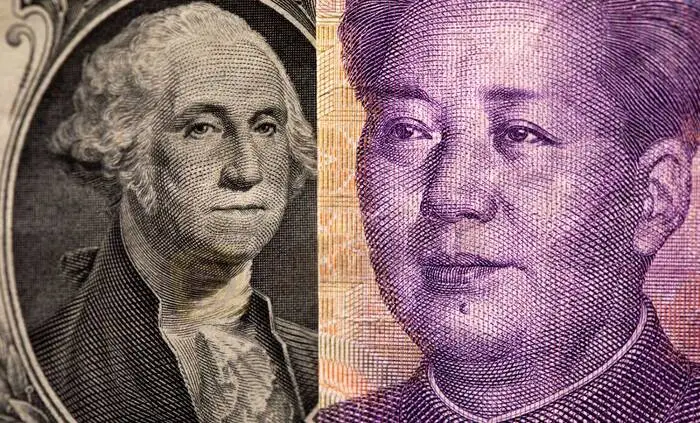简体中文
繁體中文
English
Pусский
日本語
ภาษาไทย
Tiếng Việt
Bahasa Indonesia
Español
हिन्दी
Filippiiniläinen
Français
Deutsch
Português
Türkçe
한국어
العربية
Dollar near 5-year peak to yen before Fed; Aussie weak amid China risks
Abstract:The dollar traded near a five-year high against the yen on Wednesday as investors awaited a Federal Reserve policy decision, with the Ukraine war and Chinas surging COVID-19 cases as the backdrop.

Treasury yields surged ahead of the Federal Open Market Committee decision, buoying the dollar against its Japanese peer, with traders fully priced for a first interest rate hike in three years, and giving 13% odds of a half-percentage point increase.
The dollar was also hovering near its highest level this month to the Aussie after commodity prices pulled back from multi-year peaks as markets stayed optimistic that Russia-Ukraine talks could lead to an end to hostilities.
Australias currency also came under pressure as top trade destination China saw new COVID cases more than doubling on Tuesday to a two-year high, raising concerns about the rising economic costs of its zero-tolerance policies to contain the disease.
Meanwhile, the euro continued its recovery from a plunge to a nearly 22-month low earlier this month.
That helped keep the dollar index stuck around 99.0, from as high as 99.415 at the start of last week.
“Whether its forlorn or otherwise, there does seem to be some enduring optimism (coming from) the fact that Russia and the Ukraine are still talking,” helping the euro to stabilise, said Ray Attrill, head of FX strategy at National Australia Bank.
For the greenback, “the bigger question will be that there is a lot of historical evidence that the dollar peaks as soon as the Fed commences the tightening cycle, so theres a lot of interest in whether what the Fed does turns out to be something of a watershed in terms of a peak,” with the dollar index topping out around 100, Attrill said.
The dollar index last stood at 98.880, down slightly from Tuesday. The euro ticked 0.14% higher to $1.09695, from a trough of $1.08060 on March 7.
The Aussie edged 0.08% higher to $0.72015, after dipping to $0.71650 in the previous session for the first time since Feb. 28.
The dollar traded at 118.21 yen after hitting 118.45 overnight, its strongest since January 2017.

Disclaimer:
The views in this article only represent the author's personal views, and do not constitute investment advice on this platform. This platform does not guarantee the accuracy, completeness and timeliness of the information in the article, and will not be liable for any loss caused by the use of or reliance on the information in the article.
Read more

Blockchain Decentralization: Empowering a Trustless Future
In recent years, blockchain technology has rapidly evolved from a niche innovation behind Bitcoin into a transformative force across industries. At its core, blockchain decentralization refers to the distribution of authority and decision-making away from a central entity and into the hands of a distributed network of participants. This shift redefines how data is stored and verified and paves the way for trustless, transparent, and resilient systems that challenge traditional centralized models.

The president of @Liberland, @Vít Jedlička come on stage, dialogue on trading security.
The 2025 WikiEXPO Hong Kong Station is about to grandly open. the president of @Liberland, @Vít Jedlička come on stage, dialogue on trading security.

Countdown: 1 day.WikiEXPO2025's first stop, Hong Kong, is about to open.
⏰ Countdown: 1 day. WikiEXPO2025's first stop, Hong Kong, is just tomorrow. Focus on transaction security and explore new investment opportunities. ???? Get ready to start now. See you tomorrow.

JustForex vs JustMarkets: A Comprehensive Comparison in 2025
Selecting the right forex broker can make the difference between trading success and frustration for most investors, especially retail investors. As retail traders gain unprecedented access to global markets, the choice between platforms like JustForex and JustMarkets becomes increasingly significant. Both brokers offer some shining features within the forex and CFD trading space, but their approaches differ in some areas.
WikiFX Broker
Latest News
The Withdrawal Trap: How Scam Brokers Lure Victims into Paying More
FCA to Investors: Think Twice Before Trusting These Brokers
Trump\s tariffs: How could they affect the UK and your money
Trump gambles it all on global tariffs he\s wanted for decades
TradingView Brings Live Market Charts to Telegram Users with New Mini App
Trump tariffs: How will India navigate a world on the brink of a trade war?
Interactive Brokers Launches Forecast Contracts in Canada for Market Predictions
Authorities Alert: MAS Impersonation Scam Hits Singapore
Stocks fall again as Trump tariff jitters continue
IG Group Acquires Freetrade for £160M to Expand UK Investment Market
Currency Calculator







